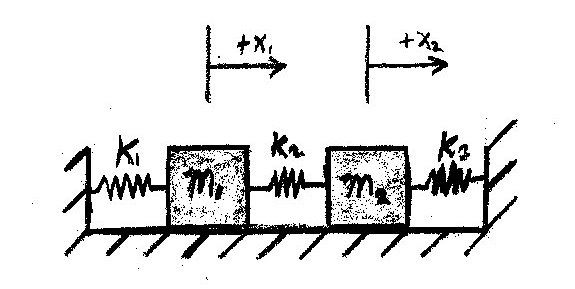|
|
| Line 242: |
Line 242: |
|
|
|
|
|
<math>e^{Bt}=\begin{bmatrix} |
|
<math>e^{Bt}=\begin{bmatrix} |
|
e^{-5.2941}&0&0&0 \\ |
|
e^{-5.2941t}&0&0&0 \\ |
|
0&e^{2.833i}&0&0 \\ |
|
0&e^{2.833it}&0&0 \\ |
|
0&0&e^{-2.83333i}&0 \\ |
|
0&0&e^{-2.83333it}&0 \\ |
|
0&0&0&e^{5.2941} |
|
0&0&0&e^{5.2941t} |
|
\end{bmatrix}\,</math> |
|
\end{bmatrix}\,</math> |
|
|
|
|
|
<math>x=T^{-1}z |
|
<math>x=T^{-1}z\,</math> |
|
|
|
|
|
<math>x=T^{-1}e^{Bt}Tx(0)\,</math> |
|
<math>x=T^{-1}e^{Bt}Tx(0)\,</math> |
Latest revision as of 23:28, 13 December 2009
Problem Statement
Write up on the Wiki a solution of a coupled oscillator problem like the coupled pendulum. Use State Space methods. Describe the eigenmodes of the system. Solve Using the Matrix Exponential

Initial Conditions:





F=ma


State Equations
 =
=

With the numbers...
 =
=

 =
=

Eigenvalues




Eigenvectors




Standard Equation










Eigenmodes
- There are two eigenmodes for the system
- 1) m1 and m2 oscillating together
- 2) m1 and m2 oscillating at exactly a half period difference
Matrix Exponential using transformation z=Tx
![{\displaystyle T^{-1}=[k_{1}|k_{2}|k_{3}|k_{4}]\,}](https://wikimedia.org/api/rest_v1/media/math/render/svg/b489191884d4a54127086ec332d536997cb30434)











 lots of variables
lots of variables
Another way to solve using the Matrix exponential
![{\displaystyle e^{At}={\mathcal {L}}^{-1}\left\{[SI-A]^{-1}\right\}\,}](https://wikimedia.org/api/rest_v1/media/math/render/svg/7e4f88ccaa345b7b19ab22653c680a22602d0674)
![{\displaystyle [SI-A]\,}](https://wikimedia.org/api/rest_v1/media/math/render/svg/6c3c74fb36f1bde7543f23c3a5d8043ba853a98e) =
=

![{\displaystyle [SI-A]^{-1}=\,}](https://wikimedia.org/api/rest_v1/media/math/render/svg/2047b23a0726b317c3aaa20eb92e668cc8485635) (something too large for my calculator to display or that I want to type out)
(something too large for my calculator to display or that I want to type out)
![{\displaystyle {\mathcal {L}}^{-1}\left\{[SI-A]^{-1}\right\}=\,}](https://wikimedia.org/api/rest_v1/media/math/render/svg/0e116deab4016153edaa8df459ded0df3650c4c6) (something too large for my calculator to display or that I want to type out)
(something too large for my calculator to display or that I want to type out)
Written by: Andrew Hellie






























![{\displaystyle T^{-1}=[k_{1}|k_{2}|k_{3}|k_{4}]\,}](https://wikimedia.org/api/rest_v1/media/math/render/svg/b489191884d4a54127086ec332d536997cb30434)












![{\displaystyle e^{At}={\mathcal {L}}^{-1}\left\{[SI-A]^{-1}\right\}\,}](https://wikimedia.org/api/rest_v1/media/math/render/svg/7e4f88ccaa345b7b19ab22653c680a22602d0674)
![{\displaystyle [SI-A]\,}](https://wikimedia.org/api/rest_v1/media/math/render/svg/6c3c74fb36f1bde7543f23c3a5d8043ba853a98e)

![{\displaystyle [SI-A]^{-1}=\,}](https://wikimedia.org/api/rest_v1/media/math/render/svg/2047b23a0726b317c3aaa20eb92e668cc8485635)
![{\displaystyle {\mathcal {L}}^{-1}\left\{[SI-A]^{-1}\right\}=\,}](https://wikimedia.org/api/rest_v1/media/math/render/svg/0e116deab4016153edaa8df459ded0df3650c4c6)